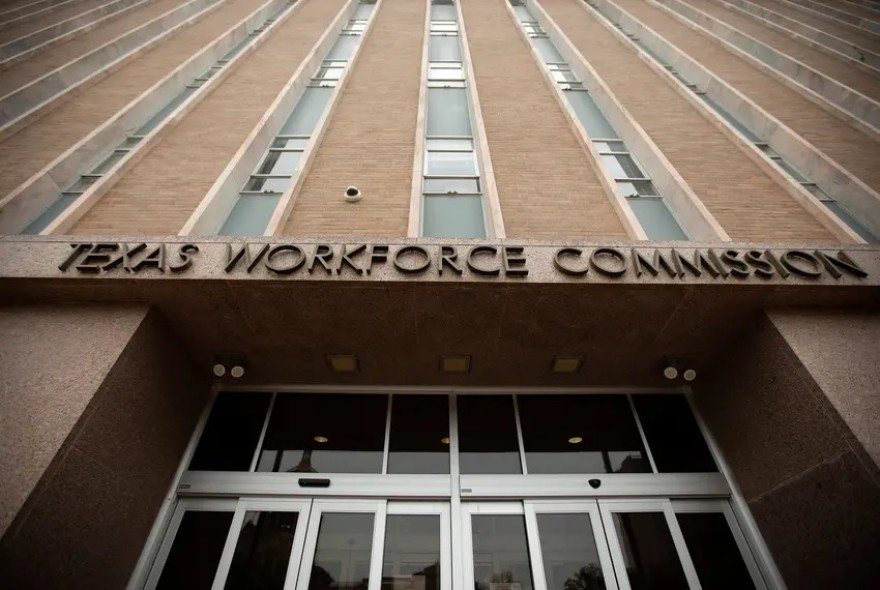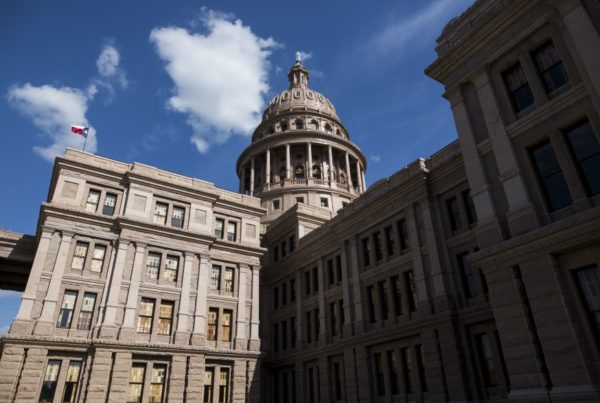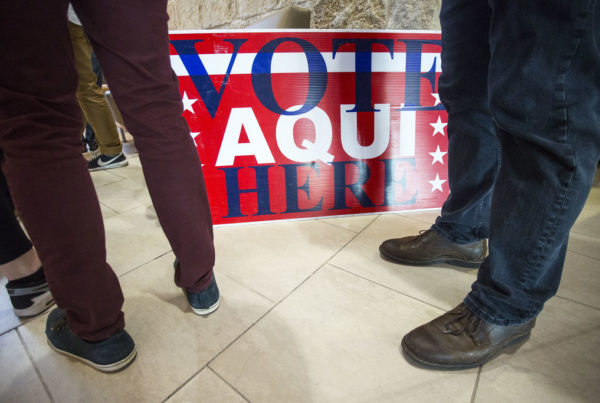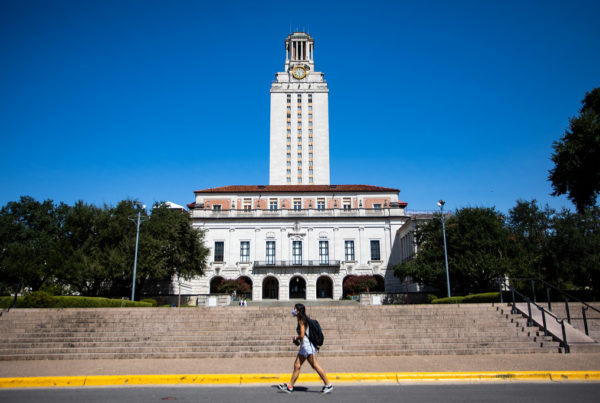From Texas Public Radio:
Texas leaders had long known they weren’t charging businesses enough unemployment insurance tax to ride out a deep, job-killing recession like the one last year.
The state was slammed with two years worth of unemployment claims in the first two months of the COVID-19 pandemic. The surge quickly drained the state’s Unemployment Insurance Trust Fund.
The federal government bailed out Texas and 22 other states. The feds footed some amount of the bill for out-of-work Texans in 10 of the past 18 months, at a cost of $7 billion.
The funding was not a gift. It was a loan to pay the 9.5 million worker claims that had been filed since last March. And now the interest is starting to build up, and Texas will begin paying it back.
State officials expect to make the first payment — as much as $12.6 million — by Sept. 30.
To cover the debt, taxes on businesses will likely go up for years. The state has until next November until automatic hikes from the federal government kick in. It will likely sell government backed bonds to avoid it.
Interest on these loans from the U.S. Treasury program Title XII — authorized by Title XII of the Social Security Act of 1935 — was suspended through much of the pandemic. But that changed on Labor Day, when the floating rate of 2.27% started to accrue. It’s not yet clear if taxpayers or businesses — or both — will feel the real cost of chronic underfunding.
But Texas may not make it through September without taking out more Title XII loans.
“[The Texas Workforce Commission, or TWC] anticipates it could start borrowing again in September,” said James Bernsen, a spokesman for the agency in June.
The state was able to cover its own unemployment claims and stop taking federal dollars in April 2021 due to the recovery, but because the interest is coming due, it is now trying to reduce its September tax burden.
“We will also more than likely begin drawing Title XII again once all available cash is used to lower the Title XII balance,” Bernsen explained in an email this week.
Texas, in effect, is paying down its credit card balance (Title XII) to lower its payment for the month, but it will need to use the federal credit card later in the month. The move suggests it will act quickly to clear the Title XII balance in one way or another.
And It Isn’t Just Texas
A 2020 analysis by the U.S. Department of Labor placed the Lone Star state 50th out of 53 states and districts in terms of unemployment funding. It was far below Puerto Rico and slightly ahead of New York, California and the Virgin Islands.
The federal government will begin charging Texas and 12 other states and districts interest next week on more than $54 billion in remaining loans taken out to pay unemployment insurance through the pandemic.
“This is red and blue, both. California, Texas, New York, they underfund the UI funds,” said William Glasgall, senior vice president of state and local initiatives at the Volcker Alliance, a nonprofit focused on government fiscal practices. “They’ll keep money in there for a normal-type recession. Because there’s no stigma, and really no penalty involved in running a very lean operation.”
Texas sits third behind New York’s $9 billion and California’s $23 billion when calculating which states drew the most money from the Treasury.
The taxes that fund unemployment insurance (UI) are collected mostly from businesses in the spring. The state’s unemployment rate has improved, dropping to 6.2% in July — less than half its pandemic height — but it’s still almost three points higher than it was prior to the beginning of the coronavirus pandemic. And indications are the recent COVID surge is slowing hiring, calling into question future Title XII loans.
The state — like many others — saw soaring unemployment rates last spring because of the pandemic, with the state unemployment rates climbing to nearly 13%. The state quickly burned through the $2 billion it collected in its Unemployment Trust Fund.
When asked why it’s only collecting about a third of what the federal government thinks it should, TWC said it was up to the legislature to set the minimum and maximum collected.
The state actually collects less money now for the unemployed than it did last year. The TWC reduced the rate going towards the UI Trust Fund so it could start saving to pay off the debt from underfunding it.
“Absent today’s Commission action, most Texas employers would have seen significant increases in their tax obligation for 2021,” said the TWC in a June press release.
The Texas legislature also reduced the amount businesses would have had to pay in unemployment taxes this year.
Since unemployment taxes for a business are based on how many people it let go the previous year, a very large bill was coming for most. Legislators and the TWC felt that would have been a huge burden for businesses at a fragile time in the recovery.
House Bill 7 changed how those bills are calculated. It gave an exemption to employers if there was a disaster declaration in effect for more than 50% of the state.
“No significant fiscal implication to the State is anticipated,” read the HB 7 fiscal note. “However, the Unemployment Trust Fund Account, held outside the State Treasury, would incur an estimated deficit of $5.4 billion for tax years 2021 and 2022.”
Many members of the business community, struggling to stay afloat, celebrated the changes.
“Right now, the most important thing is to have every possible policy directed at getting people back to work,” said Glenn Hamer, president of the Texas Association of Business. “And business taxes play a role in how many people are going to be in our labor force.”
Wayne Vroman, an economist and senior researcher the Urban Institute, said that argument — the one where the money is better off in the employer’s hands rather than the trust fund — is also the one that kept Texas’ unemployment trust underfunded to begin with.
“That assertion has never really been tested by the economics profession to know if it’s an argument that holds water or not,” Vroman said.
He added that Texas is unique in its dedication to that philosophy. “No other state has been as ardent on that idea,” he said.
Furthermore, unemployment insurance nationally isn’t a huge expense for employers, at about six tenths of a percent of payroll. Many other payroll items like Social Security far exceed it.
“So unemployment insurance is a cost. But it’s not a huge cost. And in a state like Texas, which has a low share of the unemployed who collect benefits, the costs are even below the national average,” he said.
Either way, the $7 billion bill — born of an underinvested unemployment system — comes due.
Businesses will still pay the cost, and now it will be higher with interest and other fees going to service debt, instead of going towards the unemployed, which is in-turn perpetuating the underfunding.
Texas began borrowing from the U.S. Treasury in June, taking out $1.3 billion in a single month. The state will owe 2.27% in interest on $6.9 billion. If those figures remain the same, the state will owe a minimum payment of $12.6 million at the end of September 2021. TWC estimates they will reduce the balance enough with current UI Trust funds to only have to pay around $10 million.

Getting unemployment benefits in Texas requires understanding a lot of the Texas Workforce Commission’s acronyms and terms. Credit:
And if Texas has an outstanding debt in November 2022, the federal government will effectively raise taxes across the board on businesses through an automatic reduction in the Federal Unemployment Insurance Tax credits. That rise goes up exponentially each proceeding year they have a debt balance with the Treasury.
An ongoing recession is not the best time to raise taxes, but it is a situation of Texas’ own making in many ways. Twenty-eight other states went through the pandemic and paid unemployed residents without turning to the federal government’s Title XII program.
So what does Texas do now? Below are a couple of options.
CARES Act
First, Texas could use money from the Coronavirus Aid, Relief, and Economic Security Act, the $2 trillion pot of money passed in March 2020. CARES money by and large couldn’t be used to pay off debt. But it did have a $150 billion fund called the Coronavirus Relief Fund for state, local, and tribal governments that could be used on workforce development and to shore up unemployment trust funds.
The Associated Press reported in May that 29 states said they may tap the fund to shore up their UI Trust funds. It isn’t clear if any of the 22 states that took Title XII loans used this fund to repay the Treasury.
According to the Urban Institute, 20 states already used $6 billion from the fund for workforce development and unemployment as of June. It wasn’t clear if any of it was used to pay back Title XII debt.
“I expect that Texas is going to seriously explore that,” Vroman explained.
Texas got about $8 billion from the Coronavirus Relief Fund. None of it went to TWC, staffers said, and it wasn’t currently clear if it will be used to pay back any Title XII debt.
Using federal relief dollars paid for by all taxpayers to shore up UI Trust funds that by law are paid by business owners would mean that taxpayers were bailing out businesses.
It could also set a negative precedent. States like Oregon or Vermont seeing California and Texas pay down their debt with free money may wonder why they bothered. “Because if they thought they were going to get free money, when their trust funds went broke, they might be less vigilant about building their trust funds,” Vroman added.
And do Vermont cheesemakers or Oregon fisherman want to be bailing out Texas when they are already paying seven times what Texas business owners are into their state’s trusts?
Ultimately, the precedent could cause other states to underfund their unemployment trusts expecting more free federal bailout dollars. That would further shift the burden of unemployment insurance taxes onto everyday taxpayers from business owners.
Issue Government Bonds
This is not the first recession, nor is it the first time that Texas has needed to pay its unemployed residents with federal dollars. Twice before, Texas has taken out Title XII loans. And twice before, it has issued bonds to pay them back. The last time, during the Great Recession of 2008, the TWC issued bonds for $1.9 billion and paid them back between 2011 and 2017.
Unlike either of these two times, the federal government was not offering up money that could be used to pay itself back, as is the situation to some extent now.
According to a report from the Urban Institute, the state ended up taking longer to pay off the debt than if it had let federal taxes ratchet up under Title XII. That said, they were able to keep yearly payments lower and — because government-backed bonds are in such demand that the state could sell them at a premium — the state saved money this way rather than allowing a federal collection.
Government-backed bonds are still very much in demand, and if/when states sell them again for this purpose, they will likely be able to sell at a premium. But it isn’t clear if they will save money.
For one, Texas owes a lot more this time.
In 2010, the state sold $1.9 billion in bonds to cover its Title XII debt. Now, the state owes more than 3.5 times that amount. The TWC hasn’t determined if it will go this route yet.
“I think it’s kinda premature to kinda make that decision, until you know where the —you know, where the field is after everything, all the dust settles,” said Chris Nelson, head of TWC finance, in a commission meeting earlier this year.
Issuing municipal bonds is highly technical and has fees attached. Many other state unemployment departments avoided issuing them for these reasons. Texas had experience issuing them after the 2000 dot-com-bust recession, and, according to a survey, this emboldened them to take the plunge.
Another reason Texas chose to issue bonds was because they had more control over how it was paid back. Under the federal government mandated scheme, taxes go up across the board. Under a bond, they can target companies who laid off the most people — i.e., companies whose employees used the unemployment system the most — to bear more of the burden. They did this with their bonds after the Great Recession.
The state — in an effort to boost employer funding— has left itself in a financial hole, owing billions to the federal government. What it does next will set precedent for future recessions, and it’s very likely Texas will continue to underfund its unemployment system to pay down debt.
Meanwhile, state officials and elected leaders will cross their fingers that another large recession doesn’t hit the state.














